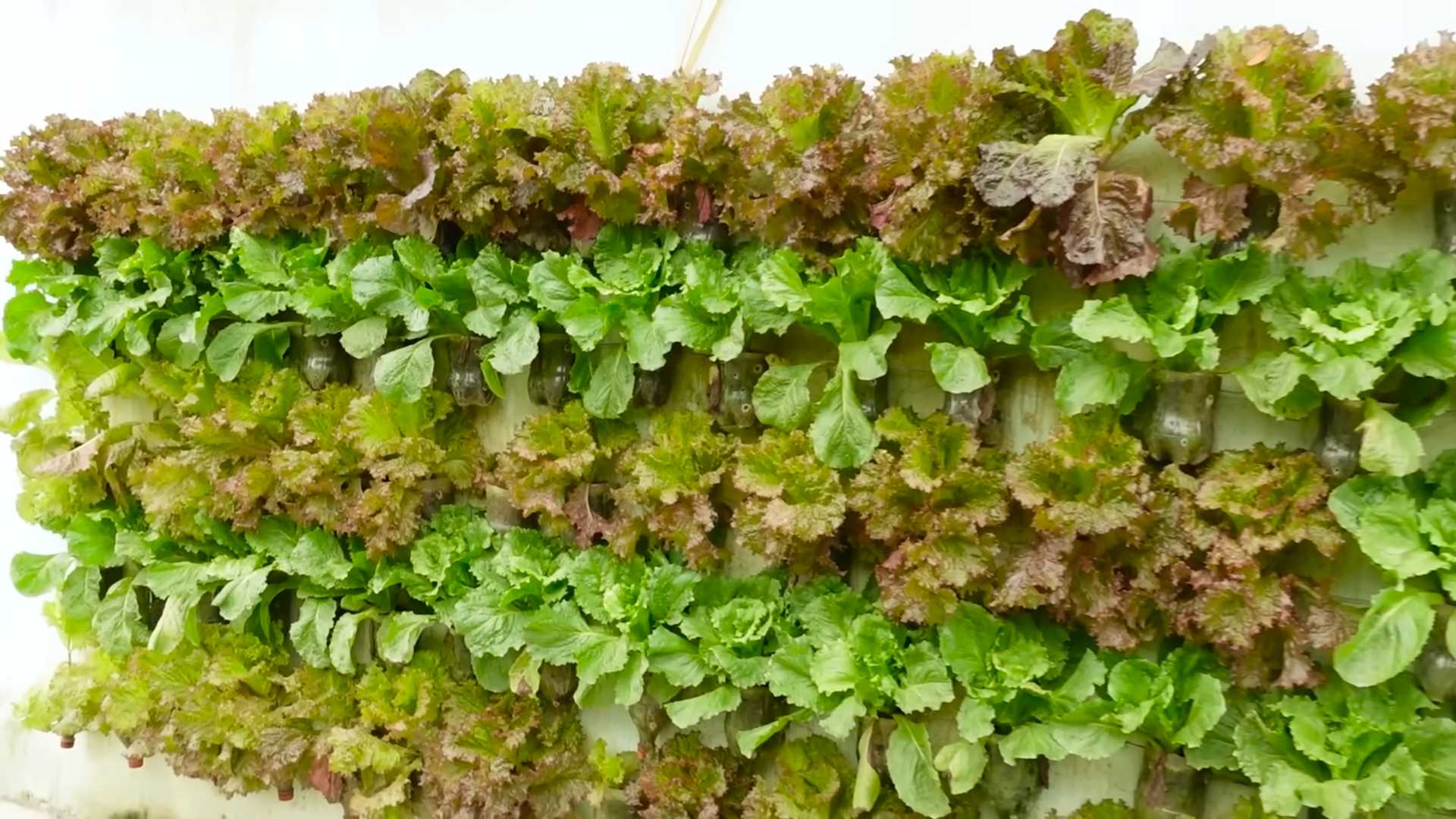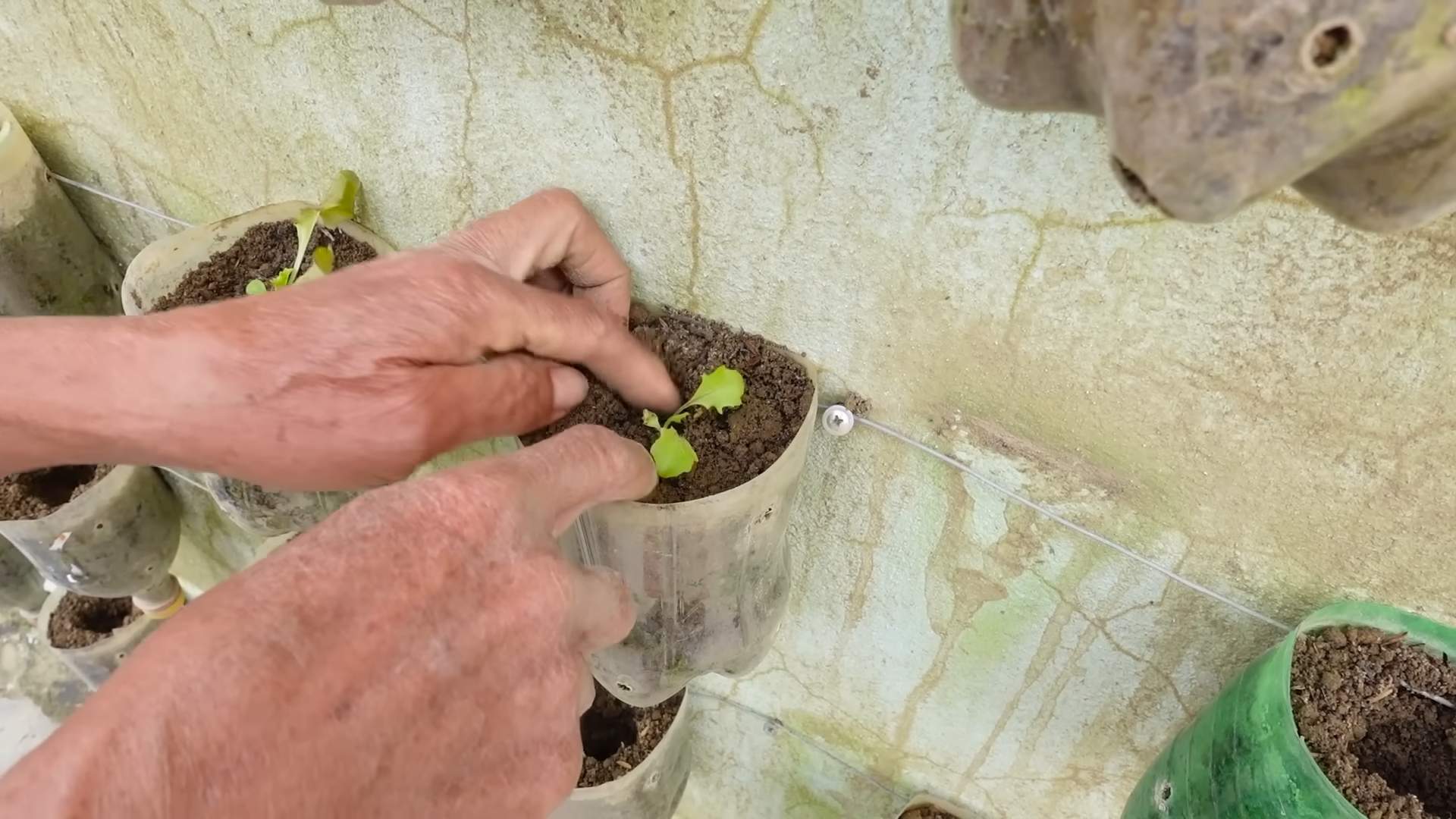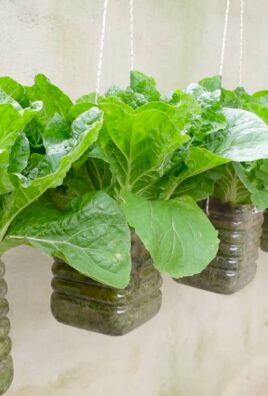Vertical garden DIY ideas are taking the gardening world by storm, and for good reason! Imagine transforming a drab, unused wall into a vibrant, living masterpiece bursting with color and life. Forget sprawling plots and back-breaking labor; we’re talking about maximizing space and minimizing effort, all while adding a touch of unique charm to your home.
The concept of vertical gardening isn’t exactly new. Think of the Hanging Gardens of Babylon, one of the Seven Wonders of the Ancient World, a testament to humanity’s long-standing fascination with elevated greenery. While we might not be building wonders on that scale, the spirit of innovation and beauty remains the same.
In today’s world, where space is often a luxury, especially in urban environments, vertical garden DIY ideas offer a brilliant solution. Whether you have a tiny balcony, a small patio, or even just an empty indoor wall, you can create a thriving garden oasis. But beyond the space-saving aspect, these DIY projects are incredibly rewarding. There’s something deeply satisfying about building something with your own hands and watching it flourish. Plus, a vertical garden can improve air quality, reduce stress, and even provide fresh herbs and vegetables right at your fingertips. So, are you ready to ditch the traditional and embrace the vertical? Let’s dive into some amazing DIY tricks and hacks that will have you growing up in no time!

DIY Vertical Garden: Bringing Green to Small Spaces
Okay, let’s dive into creating your own stunning vertical garden! I’m going to walk you through a couple of different methods, perfect for adding a touch of nature to even the smallest balconies or indoor walls. We’ll cover a simple pallet garden and a more structured, multi-tiered planter system. Get ready to get your hands dirty (in a good way!).
Pallet Vertical Garden: Rustic Charm
This is a fantastic option if you’re looking for a budget-friendly and rustic aesthetic. Pallets are often free or very inexpensive, and they’re surprisingly versatile.
Materials You’ll Need:
* A wooden pallet (look for heat-treated pallets marked “HT” to avoid chemically treated ones)
* Heavy-duty landscape fabric
* Staple gun and staples
* Gloves
* Scissors or utility knife
* Potting soil
* Plants (herbs, succulents, strawberries, leafy greens – choose plants that stay relatively small)
* Sandpaper (optional, for smoothing rough edges)
* Wood sealant or paint (optional, for weatherproofing)
* Measuring tape
* Safety glasses
Step-by-Step Instructions:
1. Prepare the Pallet: First things first, inspect your pallet. Remove any loose nails or staples. If the wood is rough, give it a light sanding. This is optional, but it’ll make the finished product look and feel nicer. Don’t forget your safety glasses!
2. Seal or Paint (Optional): If you plan to keep your vertical garden outdoors, consider applying a wood sealant or paint to protect it from the elements. Let it dry completely according to the product instructions. This will significantly extend the life of your pallet garden. I usually apply two coats for maximum protection.
3. Measure and Cut the Landscape Fabric: This is where we create the “pockets” for our plants. Measure the width and depth of each section of the pallet where you want to plant. You’ll need enough landscape fabric to line each section and create a pouch to hold the soil. Add a few extra inches to each measurement for overlap and stapling.
4. Attach the Landscape Fabric: Now, grab your staple gun and start attaching the landscape fabric to the back and sides of each section. Make sure the fabric is taut and secure. You want to create a sturdy pocket that won’t sag or tear when filled with soil. Overlap the fabric generously to prevent soil from leaking out. I usually staple along the edges about an inch apart for extra security.
5. Reinforce the Bottom (Important!): The bottom of each pocket needs extra reinforcement. Fold the landscape fabric over itself several times at the bottom to create a strong base. Staple it securely. This is crucial because the bottom will bear the weight of the soil and plants.
6. Fill with Potting Soil: Once all the pockets are lined and reinforced, it’s time to add the potting soil. Use a good quality potting mix that drains well. Fill each pocket almost to the top, leaving a little room for the plants.
7. Plant Your Plants: Gently remove your plants from their containers and loosen the roots slightly. Plant them in the soil-filled pockets, making sure the roots are well covered. Water thoroughly after planting.
8. Watering and Maintenance: Water your vertical garden regularly, especially during hot weather. Check the soil moisture by sticking your finger into the soil. If it feels dry, it’s time to water. You may also need to fertilize your plants occasionally.
9. Positioning Your Pallet Garden: Choose a location that gets adequate sunlight for your chosen plants. Lean the pallet against a wall or fence, or mount it securely using brackets. Make sure it’s stable and won’t tip over.
Multi-Tiered Planter Vertical Garden: Modern Elegance
This method involves creating a more structured vertical garden using individual planters arranged in tiers. It’s a bit more involved than the pallet garden, but the result is a sleek and modern look.
Materials You’ll Need:
* Several identical planters (choose a size and style that you like)
* A sturdy frame or support structure (you can build one from wood, metal, or purchase a pre-made vertical garden frame)
* Screws or bolts (depending on your frame)
* Drill (if needed)
* Potting soil
* Plants (again, choose plants that are suitable for vertical gardening)
* Measuring tape
* Level
* Gloves
* Wood sealant or paint (if using a wooden frame)
Step-by-Step Instructions:
1. Prepare the Frame: If you’re building your own frame, start by cutting the wood or metal to the desired size. Assemble the frame using screws or bolts. Make sure it’s sturdy and level. If you’re using a wooden frame, consider applying a wood sealant or paint to protect it from the elements. Let it dry completely. If you bought a pre-made frame, make sure it is assembled correctly and stable.
2. Planter Placement: Before attaching the planters, plan out their placement on the frame. Use a measuring tape and level to ensure they’re evenly spaced and aligned. Consider the size and shape of your plants when deciding on the spacing. You want to give them enough room to grow without overcrowding.
3. Attach the Planters: This step will vary depending on the type of frame and planters you’re using. Some frames have built-in brackets or shelves for the planters to sit on. Others may require you to drill holes and attach the planters with screws or bolts. Make sure the planters are securely attached to the frame. I like to use washers to distribute the weight and prevent the screws from pulling through the planter.
4. Add Potting Soil: Once the planters are attached, fill them with potting soil. Use a good quality potting mix that drains well. Leave a little room at the top for watering.
5. Plant Your Plants: Gently remove your plants from their containers and loosen the roots slightly. Plant them in the soil-filled planters, making sure the roots are well covered. Water thoroughly after planting.
6. Watering and Maintenance: Water your vertical garden regularly, especially during hot weather. Check the soil moisture by sticking your finger into the soil. If it feels dry, it’s time to water. You may also need to fertilize your plants occasionally.
7. Positioning Your Multi-Tiered Garden: Choose a location that gets adequate sunlight for your chosen plants. Make sure the frame is stable and won’t tip over. You may need to anchor it to a wall or fence for extra security.
Choosing the Right Plants
No matter which method you choose, selecting the right plants is crucial for a successful vertical garden. Here are a few things to consider:
* Sunlight: How much sunlight does your vertical garden location receive? Choose plants that are suited to the amount of sunlight available.
* Size: Select plants that stay relatively small and compact. You don’t want them to outgrow their space too quickly.
* Watering Needs: Consider the watering needs of your chosen plants. Group plants with similar watering requirements together.
* Maintenance: Choose plants that are relatively low-maintenance. You don’t want to spend all your time tending to your vertical garden.
Here are some popular plant choices for vertical gardens:
* Herbs: Mint, basil, thyme, oregano, rosemary
* Succulents: Echeveria, sedum, sempervivum
* Strawberries: Alpine strawberries are a great choice for vertical gardens.
* Leafy Greens: Lettuce, spinach, kale
* Trailing Plants: Pothos, ivy, creeping fig
Troubleshooting Tips
* Soil Drying Out Too Quickly: If your soil is drying out too quickly, try adding some water-retaining crystals to the potting mix. You can also mulch the soil surface to help retain moisture.
* Plants Turning Yellow: Yellowing leaves can be a sign of overwatering or underwatering. Check the soil moisture and adjust your watering schedule accordingly. It could also be a nutrient deficiency, so consider fertilizing your plants.
* Pests: Keep an eye out for pests like aphids, spider mites, and whiteflies. Treat them promptly with an appropriate insecticide or organic pest control method.
* Sagging Pockets (Pallet Garden): If the pockets in your pallet garden are sagging, it could be due to the weight of the soil and plants. Reinforce the pockets with additional landscape fabric and staples. You may also need to add some support to the back of the pallet.
Remember to have fun and experiment! Vertical gardening is a rewarding way to bring nature into your life, even if you’re short on space. Don’t be afraid to try different plants and arrangements until you find what works best for you. Happy gardening!

Conclusion
So, there you have it! Creating your own vertical garden isn’t just a trendy project; it’s a transformative experience that brings nature closer, maximizes space, and adds a unique touch to your home. We’ve explored several fantastic DIY approaches, from repurposing pallets to crafting elegant hanging planters. The beauty of these projects lies in their adaptability. Whether you’re a seasoned gardener or a complete beginner, there’s a vertical garden DIY idea here to suit your skill level and aesthetic preferences.
Why is this a must-try? Because it’s more than just gardening. It’s about sustainability, creativity, and connecting with the natural world in a meaningful way. Imagine stepping onto your balcony or into your kitchen and being greeted by a vibrant wall of herbs, flowers, or even vegetables. The air is fresher, the space is more inviting, and you have the satisfaction of knowing you created something beautiful and functional with your own hands.
Don’t be afraid to experiment! Consider variations like using different types of containers – think upcycled tin cans, repurposed plastic bottles, or even old shoes for a quirky touch. Play with different plant combinations. Succulents are fantastic for low-maintenance vertical gardens, while herbs like basil, mint, and rosemary thrive in sunny spots. If you’re feeling ambitious, try incorporating a small irrigation system to make watering a breeze. You can also add decorative elements like fairy lights or painted designs to personalize your vertical garden even further.
The possibilities are truly endless. The key is to start small, be patient, and enjoy the process. Remember to choose plants that are well-suited to your climate and the amount of sunlight your vertical garden will receive. Proper drainage is also crucial to prevent root rot.
We’re confident that you’ll find immense satisfaction in creating your own vertical oasis. It’s a rewarding project that will bring joy and beauty to your life for years to come. So, gather your materials, unleash your creativity, and get ready to transform your space with a stunning vertical garden.
We’re eager to hear about your experiences! Share your photos, tips, and challenges in the comments below. Let’s build a community of vertical gardening enthusiasts and inspire each other to create even more amazing green spaces. What plants did you choose? What challenges did you overcome? What unique design elements did you incorporate? Your insights will be invaluable to others who are embarking on their own vertical gardening journeys. Let’s grow together!
Frequently Asked Questions (FAQs)
What exactly is a vertical garden, and why should I consider one?
A vertical garden, also known as a living wall, is a gardening technique where plants are grown on a vertically suspended panel using hydroponics or soil. Instead of planting on the ground, plants are grown upwards, often on walls or other vertical structures. There are numerous reasons to consider a vertical garden. They are excellent for small spaces, such as apartments or balconies, where traditional gardening isn’t feasible. They improve air quality by filtering pollutants and releasing oxygen. They add aesthetic appeal to any space, creating a calming and visually stunning environment. Furthermore, they can provide insulation, helping to regulate temperature and reduce energy costs. Finally, they offer a unique and rewarding gardening experience.
What types of plants are best suited for vertical gardens?
The best plants for vertical gardens are those that are relatively compact, have shallow root systems, and can tolerate the growing conditions of your specific location. Some popular choices include:
* **Succulents:** These are drought-tolerant and require minimal maintenance, making them ideal for beginners. Varieties like sedum, echeveria, and sempervivum are excellent choices.
* **Herbs:** Many herbs, such as basil, mint, rosemary, thyme, and oregano, thrive in vertical gardens. They are fragrant, useful in cooking, and relatively easy to grow.
* **Lettuce and Salad Greens:** These can be grown in vertical gardens, providing fresh greens for salads and sandwiches.
* **Strawberries:** These are a fun and rewarding option for vertical gardens, especially for families with children.
* **Trailing Plants:** Plants like pothos, ivy, and creeping fig add a cascading effect to vertical gardens, creating a lush and visually appealing display.
* **Ferns:** These thrive in shady, humid environments and add a touch of elegance to vertical gardens.
* **Small Flowering Plants:** Plants like petunias, impatiens, and pansies add color and vibrancy to vertical gardens.
Consider the amount of sunlight your vertical garden will receive when choosing plants. Some plants prefer full sun, while others thrive in partial shade. Also, consider the climate in your area and choose plants that are well-suited to the local conditions.
How do I water a vertical garden?
Watering is a crucial aspect of maintaining a healthy vertical garden. The frequency of watering will depend on the type of plants you have, the climate, and the type of growing medium you are using. Generally, you should water your vertical garden when the soil feels dry to the touch.
There are several ways to water a vertical garden:
* **Hand Watering:** This is the simplest method, where you use a watering can or hose to water each plant individually. Be sure to water thoroughly, allowing the water to drain through the soil.
* **Drip Irrigation:** This is a more efficient method that delivers water directly to the roots of the plants. You can install a drip irrigation system with emitters placed near each plant.
* **Self-Watering Systems:** These systems use a reservoir of water that is gradually released to the plants as needed. They are ideal for busy gardeners or those who travel frequently.
Regardless of the method you choose, be sure to avoid overwatering, as this can lead to root rot. Also, consider using a fertilizer solution when watering to provide your plants with the nutrients they need to thrive.
What kind of soil should I use for my vertical garden?
The ideal soil for a vertical garden is a well-draining mix that retains moisture but doesn’t become waterlogged. A good option is a mix of potting soil, perlite, and vermiculite. The potting soil provides nutrients, while the perlite and vermiculite improve drainage and aeration. You can also add some compost to the mix to provide additional nutrients.
Avoid using garden soil, as it can be too heavy and compact, leading to poor drainage and root rot. Also, consider using a soil mix that is specifically formulated for container gardening.
How much sunlight does my vertical garden need?
The amount of sunlight your vertical garden needs will depend on the types of plants you are growing. Most plants require at least six hours of sunlight per day, but some can tolerate partial shade. If you are growing plants that require full sun, be sure to place your vertical garden in a location that receives plenty of sunlight. If you are growing plants that prefer partial shade, be sure to protect them from the harsh afternoon sun.
If you don’t have enough natural sunlight, you can supplement with artificial lighting. Grow lights are a great option for indoor vertical gardens.
How do I prevent pests and diseases in my vertical garden?
Preventing pests and diseases is essential for maintaining a healthy vertical garden. Here are some tips:
* **Choose disease-resistant plants:** When selecting plants for your vertical garden, choose varieties that are known to be resistant to common pests and diseases.
* **Provide good air circulation:** Good air circulation helps to prevent fungal diseases. Be sure to space your plants properly and avoid overcrowding.
* **Water properly:** Avoid overwatering, as this can create a breeding ground for pests and diseases.
* **Inspect your plants regularly:** Check your plants regularly for signs of pests or diseases. If you find any, take action immediately.
* **Use organic pest control methods:** If you need to control pests, use organic methods such as insecticidal soap or neem oil.
* **Remove dead or diseased leaves:** Remove any dead or diseased leaves promptly to prevent the spread of disease.
How often should I fertilize my vertical garden?
The frequency of fertilization will depend on the type of plants you have and the type of fertilizer you are using. Generally, you should fertilize your vertical garden every two to four weeks during the growing season. Use a balanced fertilizer that is specifically formulated for container gardening. Follow the instructions on the fertilizer label carefully.
Can I grow vegetables in a vertical garden?
Yes, you can definitely grow vegetables in a vertical garden! Some vegetables that thrive in vertical gardens include lettuce, spinach, kale, tomatoes (smaller varieties like cherry tomatoes), peppers, and herbs. Be sure to choose a sunny location and provide adequate support for the plants as they grow.
How do I build a DIY vertical garden on a budget?
Building a DIY vertical garden on a budget is entirely possible! Here are some tips:
* **Repurpose materials:** Use recycled materials like pallets, plastic bottles, tin cans, and old wooden crates to create your vertical garden structure.
* **Collect free materials:** Ask friends, neighbors, or local businesses for discarded materials that you can use.
* **Start small:** Begin with a small vertical garden and gradually expand it as your budget allows.
* **Grow from seeds:** Growing plants from seeds is much cheaper than buying seedlings.
* **Make your own potting mix:** Create your own potting mix by combining compost, perlite, and vermiculite.
* **Shop around for





Leave a Comment